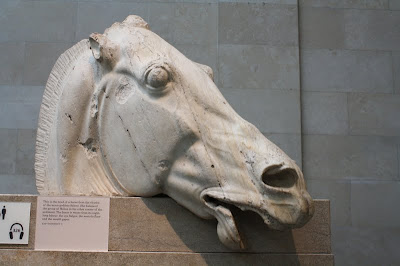The British Museum is a living testament that the Brits have looted every major ancient civilization. The collections are, of course, phenomenal, but you can understand why other countries would like to have the treasures of their civilizations back. In their defense, the Brits claim, "Well, other countries have some of the treasures, too. We're not the only ones." In other words, "What about Canada, they have a piece or two, are you going to ask them to give their's back?"
Jordan with a Lion in the Great Court of the Museum
One of the first things that we saw upon arrival was the Rosetta Stone. Later we saw a copy of the stone and the manner in which it was originally displayed. Initially, people could actually touch it. Later, when they realized the damage that was being done to it, they put it behind plexiglass.
The Egyptian artifacts are unreal. Pictures simply cannot capture their size and beauty.
Robert as art, again. We think Madonna's "Vogue" circulates constantly in his mind. At the very sight of art, he "strikes the pose."
Sarcophagus
The Maltese Falcon
His Cousin, The Maltese Hawk
A four-inch replica of this piece was for sale in the gift shop for 135 pounds--nice,
but not that nice
Detail from the lid of a sarcophagus
Massive Scarab
Compare with the size of the people in the background
Four of these massive winged lions flanked two doorways
If you are going to plunder, get bunches while the getting is good.
One of the Ramses boys--there were several.
A Frieze from Abyssinia
One of the few modest Greek statues. Completely appropriate for Victorian England,
where the pretense of modesty was most important.
This small temple/tomb had a room to itself
These two pieces were part of the original carvings from the pediment of the Parthenon in Greece.
Greece has called, more than once, and they'd like their history back.
Another view of the massive Scarab
Mosaic Pavements
Robert particularly asked for a photograph of this Egyptian.
Curt (pictured above) was a wealthy accountant.
Mummified Horse
The Museum has an impressive number of mummies from a variety of cultures covering numerous centuries. Many of them have paintings of the individual. If you look into the distance in this picture, you can see the portrait of the young man mummified here.
A smaller Scarab
Whether ceramic or painted, "the eyes have it."
This display explains what skulls and teeth can tell us about the diet and nutrition of ancient people.
Blue burial ornaments. We also saw these in Paris.
This mummified body retained the shape of the original body.
This body was buried in the desert sands surrounded by the implements he used in life. The mummification visible here was the result of natural forces--the dry sands of the desert--rather than the practices of ancient morticians.
A final sphinx































And, pray tell, what DO skulls and teeth can tell us about the diet and nutrition of ancient people?
ReplyDeleteWell, pretty much, if you're down to the skull and the teeth, you can bet the subject is undernourished.
ReplyDeleteAs you went through this museum did you have the same feeling I did that really the British should give some of this back . . .
ReplyDelete